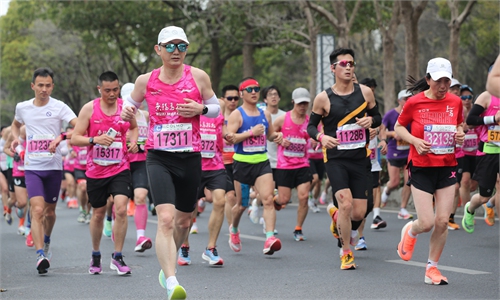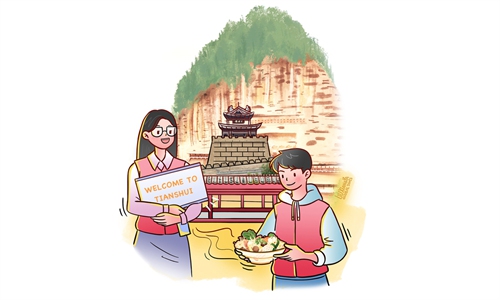LIFE / ATTITUDES
Turning viral visits into vibrant wealth

Illustration: Liu Xiangya/GT
Tourism is a comprehensive industry and a significant driving force for economic development. A dish, TV drama, or other forms of entertainment can make a city an overnight sensation nowadays. As internet-famous cities take turns in the spotlight, many cities are vying to join the club that included Rongjiang, Zibo, Harbin and Tianshui. However, does a surge in visitor traffic inevitably signify robust business?Zhangjiajie City in Hunan Province, renowned for its stunning natural beauty and listed as a UNESCO World Natural Heritage Site, received 20.64 million domestic and international tourists in the first half of 2024, a year-on-year increase of 9.28 percent.
Harbin, the capital of Heilongjiang Province in Northeast China, saw a total tourist volume increase of 41.4 percent in 2023, while the total tourism revenue was up 7.4 percent that year compared to 2019.
2023's hottest internet-famous city, Zibo, located in the central part of Shandong Province, witnessed its annual GDP in 2023 grow by 5.5 percent compared to the previous year, which was caused by booming visitor traffic. There is still room for further growth as this was below the average growth rate of 6 percent for Shandong Province.
While tourism volume is booming around the country, there are still means to further improve the tourist experience and turn it into business figures.
Firstly, the absence of differentiation due to insufficient innovation has led to subpar experiences. Glass skywalks, high-altitude swings, and river rafting have become standard attractions in many scenic areas. Visitors are disinterested in experiencing them again just in a different place. In addition, many tourists have commented on social platforms that there is a significant discrepancy between online and offline experiences in some internet-famous cities, with a strong commercial atmosphere and high prices at tourist attractions.
Secondly, pursuing "value for money" is affecting tourism revenue growth. Many young tourists who visit internet-famous cities focus on getting the most out of their travel experience with the smallest budget. No wonder there has been the rise of special forces-style tourism and city walks in recent years.
Thirdly, failing to create a "long-tail effect" is a common dilemma. Massive internet traffic comes and goes quickly. While this mode of communication can quickly gather a lot of attention and traffic, its popularity is often fleeting. Once a new hotspot emerges, the former can easily be replaced, leading to a rapid decline in tourist traffic and attention.
Besides this, the industry structure needs more diversity. Harbin, Zibo, and Tianshui are all traditional industrial cities. While the tourism industry can bring a certain economic vitality and visibility to the city, it may limit revenue growth potential if the consumption structure is singular without diversified consumer experiences. Urban economies' diversification and sustainable development require the collaborative development of multiple industries.
How can the traffic be sustained and monetized over the long term?
To begin with, it is essential to extend the industrial chain, increase investment in infrastructure and public services, and continuously optimize the product structure by integrating the cultural and tourism industry with other industries to maximize economic value. The charm of a cultural tourism city stems from the comprehensive and in-depth integration of culture, tourism, cuisine, performing arts, and sports activities. This multidimensional collaborative development builds a unique and enduring appeal.
Innovation based on local culture is critical to creating a unique experience and ensuring that a city's originality is not easily replicated. For instance, by revitalizing historic districts and cultural heritage through modern design and technology, cities can preserve their historic charm while also integrating it into contemporary life. This approach can attract tourists interested in history or seeking innovative experiences.
Taoxichuan Market, located in Jingdezhen, a small city famous for its ceramic industry in East China's Jiangxi Province, was transformed from an old factory into a modern urban art district. It has introduced unique businesses such as pottery training and music education and regularly hosts markets, exhibitions, and concerts to attract visitors. It has now become a calling card for Jingdezhen.
In addition, it is important to establish a community culture in marketing. Cities must create online and offline community platforms centered around their uniqueness to connect tourists and residents with shared interests. They must also boost their overall popularity and consumption through regular activities and interactions, increasing the connection between visitors and the travel destination. This "bottom-up" approach not only strengthens the sense of belonging for participants but also contributes humanity and sustainability to urban development.
Being an internet sensation is just the first step. Turning one-time visitors into repeat patrons is a long-term endeavor that requires high-quality services, products, and experiences, as well as support from relevant policies and creating an overall social atmosphere. Relying on history and culture to expand the development of tourism is vital. When the tide of traffic in internet-famous cities recedes, the competition of industries, innovation, internal strengths, and deep cultivation has just begun.
The author is a faculty member with the School of Applied Economics at Renmin University of China. life@globaltimes.com.cn



